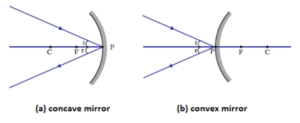CHARACTERISTICS OF IMAGES FORMED BY PLANE MIRRORS
The characteristics of images formed by plane mirrors are:
- The image of real object is always virtual. Such image cannot be taken on a screen.
- The image formed in a plane mirror is always erect.
- The size of the image in a plane mirror is always the same as the size of the object.
- The image formed in a plane mirror is as far behind the mirror, as the object is in front of the mirror.
- The image formed in a plane mirror is laterally inverted i.e. the left side of the objects becomes the right side of the image and vice-versa.
SPHERICAL MIRROR
A spherical mirror is that mirror whose reflecting surface is the part of a hollow sphere of glass. The spherical mirrors are of two types: Concave mirror and Convex mirror.
CONCAVE MIRROR: A concave mirror is that spherical mirror in which the reflection of light takes place at the concave surface (or bent-in surface).
CONVEX MIRROR: A convex mirror is that spherical mirror in which the reflection of light takes place at the convex surface (or bulging –out surface).

TERMS RELATED TO SPHERICAL MIRRORS
Centre of Curvature(C): The center of curvature of a spherical mirror is the center
of the hollow sphere of glass of which the spherical mirror is a part. It is represented by letter ‘C’.
Pole(P): The pole of a spherical mirror is the center of the mirror. It is represented by letter ‘P’.
Radius of Curvature(R): The radius of curvature of a spherical mirror is the radius of the hollow sphere of glass of which the spherical is a part. It is represented by the letter ‘R’.
Principal axis: The principal axis of a spherical mirror is the straight line passing through the center of curvature C and pole P of the spherical mirror, produced on both sides.
Aperture: The aperture of a spherical mirror is the diameter of the reflecting surface of the mirror.
PRINCIPAL FOCUS OF A SPHERICAL MIRROR
The principal focus of a concave mirror is a point on its principal axis to which all the light rays which are parallel and close to the axis, converge after reflection from the concave mirror. A concave mirror has a real focus. The focus of a concave mirror is in front of the mirror. Since a concave mirror converges a parallel beams of light rays, it is also called converging mirror.
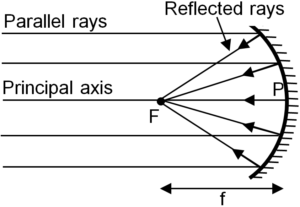
The principal focus of a convex mirror is a point on its principal axis from which a beam of light rays, initially parallel to the axis, appears to diverge after being reflected from the convex mirror. A convex mirror has a virtual focus. The focus of a convex mirror is situated behind the mirror. Since a convex mirror diverges a parallel beams of light rays, it is also called diverging mirror.
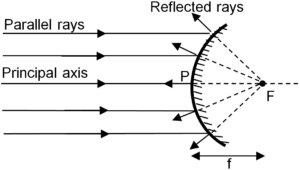
Focal Length: The focal length of a spherical mirror is the distance between its pole and principal focus. It is denoted by the letter ‘f’.
Relation between radius of curvature and focal length of a spherical mirror
The focal length of a spherical mirror is equal to half of its radius of curvature.
In other words, for spherical mirrors of small apertures, the radius of curvature is found to be equal to twice the focal length.
R = 2f
RULES FOR OBTAINING IMAGES FORMED BY SHPERICAL MIRRORS
The intersection of at least two reflected rays give the position of image of the point object. Any two of the following rays can be considered for locating the image.
1. A ray parallel to the principal axis, after reflection, will pass through the principal focus in case of a concave mirror or appear to diverge from the principal focus in case of a convex mirror.
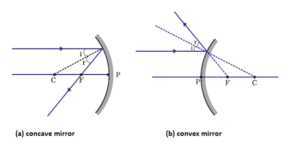 2. A ray passing through the principal focus of a concave mirror or a ray which is directed towards the principal focus of a convex mirror, after reflection, will emerge parallel to the principal axis.
2. A ray passing through the principal focus of a concave mirror or a ray which is directed towards the principal focus of a convex mirror, after reflection, will emerge parallel to the principal axis.
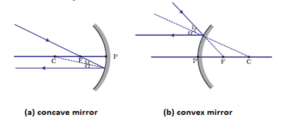 3. A ray passing through the center of curvature of a concave mirror or directed in the direction of the center of curvature of a convex mirror, after reflection, is reflected back along the same path. The light rays come back along the same path because the incident rays fall on the mirror along the normal to the reflecting surface.
3. A ray passing through the center of curvature of a concave mirror or directed in the direction of the center of curvature of a convex mirror, after reflection, is reflected back along the same path. The light rays come back along the same path because the incident rays fall on the mirror along the normal to the reflecting surface.
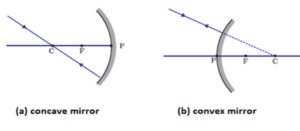 4. A ray incident obliquely to the principal axis, towards a point P (pole of the mirror), on the concave mirror or a convex mirror , is reflected obliquely. The incident and reflected rays follow the laws of reflection at the point of incidence (point P), making equal angles with the principal axis.
4. A ray incident obliquely to the principal axis, towards a point P (pole of the mirror), on the concave mirror or a convex mirror , is reflected obliquely. The incident and reflected rays follow the laws of reflection at the point of incidence (point P), making equal angles with the principal axis.
